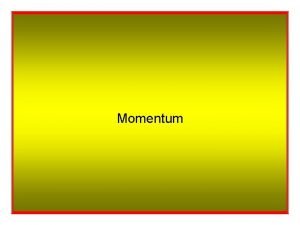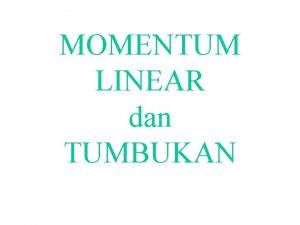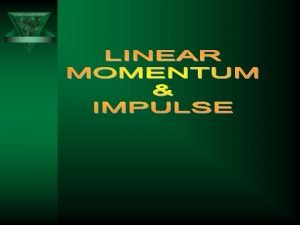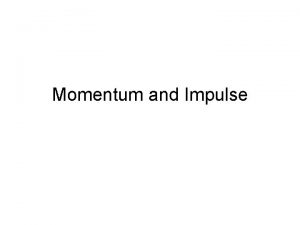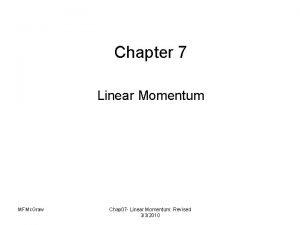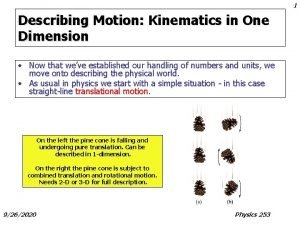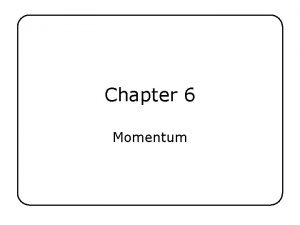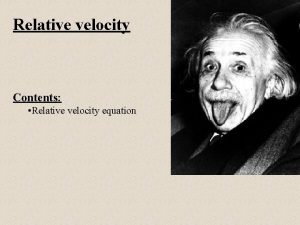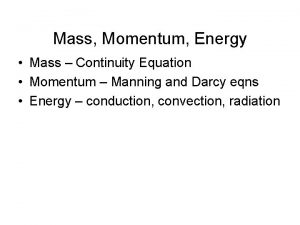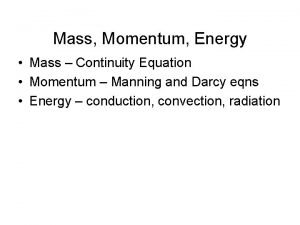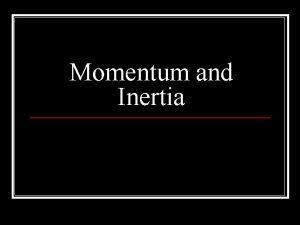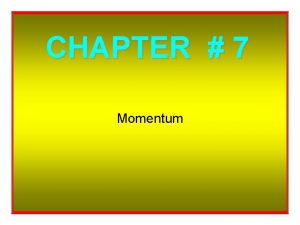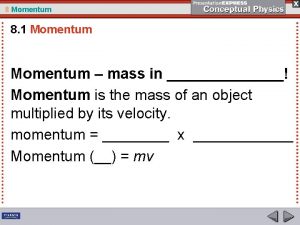Momentum mass x velocity The equation for momentum














- Slides: 14

Momentum = mass x velocity The equation for momentum is written as: Ρ = mv If direction is not an important factor : momentum = mass x speed A slow moving truck and an extremely fast roller skate can have the same momentum.

Question : Under what circumstances would the roller skate and the truck have the same momentum ? The roller skate and truck can have the same momentum if the ratio of the speed of the skate to the speed of the truck is the same as the ratio of the mass of the truck to the mass of the skate. A 1000 kg truck moving at 0. 01 m/sec has the same momentum as a 1 kg skate moving at 10 m/sec. Both have a momentum of 10 kg m/sec. ( 1000 x. 01 = 1 x 10 = 10 )

-is defined as the product of the mass and velocity -is based on Newton’s 2 nd Law F=ma F = m Δv t IMPULSE F t = m Δv MOMENTUM

MOMENTUM An object at rest has no momentum, why? Because anything times zero is zero (the velocity component is zero for an object at rest) FORCE To INCREASE MOMENTUM, apply the greatest force possible for as long as possible. Examples : pulling a sling shot drawing an arrow in a bow all the way back a long cannon for maximum range hitting a golf ball or a baseball. (follow through is important for these !) TIME

MOMENTUM DEFINITION OF TERMS : impulse : impact force X time (newton. sec). F t = impulse impact : the force acting on an object (N) when it hits something. impact forces : average force of impact

MOMENTUM Decreasing Momentum Which will provide lesser impact force for the car ? mv Ft mv Knowing the physics helps us understand why hitting a soft object is better than hitting a hard one. Ft

MOMENTUM In each case, the momentum is decreased by the same amount or impulse (force x time) Hitting the haystack extends the impact time (the time in which the momentum is brought to zero). The longer impact time reduces the force of impact and decreases the deceleration. To decrease the force of impact, the time of impact must be extended!

DECREASING MOMENTUM If the time of impact is increased by 100 times (for example, from. 01 sec to 1 sec), then the force of impact is reduced by 100 times (relatively survivable). EXAMPLES : Padded dashboards on cars Airbags in cars or safety nets in circuses Moving your hand backward as you catch a fast-moving ball with your bare hand or a boxer moving with a punch. Flexing your knees when jumping from a higher place to the ground. Elastic cords for bungee jumping Using wrestling mats instead of hardwood floors. Dropping a glass dish onto a carpet instead of a sidewalk.

n EXAMPLES OF DECREASING MOMENTUM In boxing … F = change in t momentum F t = change in momentum n n Increased impact time reduces force of impact Ft = Δmv applies here. In bungee Jumping … mv = the momentum gained before the cord begins to stretch that we wish to change. Ft = the impulse the cord supplies to reduce the momentum to zero. Because the rubber cord stretches for a long time the average force on the jumper is small.

Questions When a dish falls, will the impulse be less if it lands on a carpet than if it lands on a hard ceramic tile floor ? The impulse would be the same for either surface because there is the same momentum change for each. It is the force that is less for the impulse on the carpet because of the greater time of momentum change. There is a difference between impulse and impact. If a boxer is able to increase the impact time by 5 times by “riding” with a punch, by how much will the force of impact be reduced? Since the time of impact increases by 5 times, the force of impact will be reduced by 5 times.

BOUNCING IMPULSES ARE GREATER WHEN AN OBJECT BOUNCES The impulse required to bring an object to a stop and then to throw it back upward again is greater than the impulse required to merely bring the object to a stop. When a martial artist breaks boards, does their hand bounce? Is impulse or momentum greater ? Example : The Pelton Wheel.

CONSERVATION OF MOMENTUM To accelerate an object, a force must be applied. The force or impulse on the object must come from outside the object. EXAMPLES : The air in a basketball, sitting in a car and pushing on the dashboard or sitting in a boat and blowing on the sail don’t create movement. Internal forces like these are balanced and cancel each other. If no outside force is present, no change in momentum is possible.

The Law of Conservation of Momentum In the absence of an external force, the momentum of a system remains unchanged. This means that, when all of the forces are internal (for EXAMPLE: the nucleus of an atom undergoing radioactive decay, cars colliding, or stars exploding. The net momentum of the system before and after the event is the same.

QUESTIONS 1. Newton’s second law states that if no net force is exerted on a system, no acceleration occurs. Does it follow that no change in momentum occurs? No acceleration means that no change occurs in velocity of momentum. 2. Newton’s 3 rd law states that the forces exerted on a cannon and cannonball are equal and opposite. Does it follow that the impulse exerted on the cannon and cannonball are also equal and opposite? Since the time interval and forces are equal and opposite, the impulses (F x t) are also equal and opposite.
 Mass x velocity
Mass x velocity Momentum=mass x velocity
Momentum=mass x velocity Momentum is mass times
Momentum is mass times Energy and momentum
Energy and momentum Velocity of center of mass equation
Velocity of center of mass equation Velocity of center of mass equation
Velocity of center of mass equation Mass to mass equation
Mass to mass equation Hydraulic conductivity equation
Hydraulic conductivity equation Linear quantity
Linear quantity Initial velocity and final velocity formula
Initial velocity and final velocity formula Final velocity initial velocity acceleration time
Final velocity initial velocity acceleration time Constant acceleration speed time graph
Constant acceleration speed time graph Instantaneous velocity vs average velocity
Instantaneous velocity vs average velocity Darcy velocity vs actual velocity
Darcy velocity vs actual velocity Tangential speed
Tangential speed
